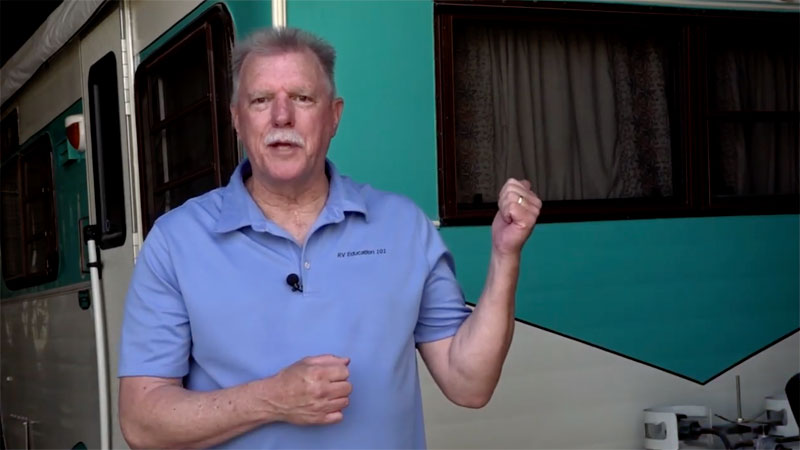Mark Polk: Hi, I’m Mark Polk with RV Education 101. Several years ago, we restored a vintage 1967 Yellowstone travel trailer.
Our goal with the restoration was to keep the original vintage look, but update it with modern day amenities found in today’s RVs. This is how we did it.
 Let’s start the journey with a little history on our vintage trailer. Our trailer is a 1967 Yellowstone Cavalier model. It is 13 feet long,
Let’s start the journey with a little history on our vintage trailer. Our trailer is a 1967 Yellowstone Cavalier model. It is 13 feet long,
or 16 feet if you measure to the front of the tongue. Based on some old advertisements I found, it weighed in at about 2,500 pounds. The interior height is 6’2, and the overall width is 7′. Measured against today’s standards, it’s not very roomy, but back in the day, this was a pretty nice amount of space for a camping trip.
We found our restoration project sitting in a backyard, and we purchased it for $300. One important consideration when you purchase a vintage trailer like this is getting it home safely. The tires are typically old, weather damaged, and low on air. The lights probably won’t work, and the brakes probably don’t work. We were prepared with what we needed to safely move the trailer, including the right size trailer ball and ball mount. But as a precautionary measure, I had Dawn follow me back to the garage in her vehicle.
When you make the decision to restore a vintage travel trailer, you need to decide how in-depth the restoration you plan to do. A major factor in this decision is your budget. I restore classic cars and trucks as a hobby, and your budget determines if it will be a frame off restoration, a less expensive restoration, or just an overhaul. One thing I can guarantee is you will end up investing more than you initially planned in the restoration.
Let the demolition begin.
The first stage of the restoration was the demo stage. We started by removing all of the windows. Our plan was to redesign the trailer’s floorplan, so we were taking the interior down to the wood framing. This would give us a good idea of the extent of water damage there was to the wood. And this is a determining factor in whether the exterior metal can stay on the trailer or it needs to be removed. Sometimes water damage is easy to spot on a trailer, and other times it’s difficult to detect. Almost any vintage trailer you find will have water damage to some extent. The question is how much damage are you willing to deal with in a restoration?
When I initially inspected this trailer, it seemed like a good candidate for restoration, but the truth will be told when you demo the trailer. The further we got into the demo stage, the more I realized we were probably going to remove the metal and take the trailer
down to the bare frame. This would be comparable to a frame off restoration on a car. Something to keep in mind as you demo the trailer that will help later in the restoration is to remove interior panels in one piece if possible. That way, you can use the old pieces as patterns to cut the new pieces, especially where curves are involved. When it was all said and done, we made the decision to remove all of the exterior metal because of the extent of water damage that we found. Be careful when you remove the exterior metal in the event you need to reuse it.
I don’t think there’s a right or wrong way to tackle a project like this, but I do think you need to have some idea of the sequence of events you would like the restoration process to follow. My preliminary thoughts were to start disassembling the trailer to see how deep some of the damage goes, and here we are.
Try to stay a step or two ahead of things, and have a plan for all of the various scenarios you might encounter. So, the first step was
to identify and remove all the damaged wood and start the process of reframing the trailer. This is an important stage, especially if you’re changing the original floorplan like us, and you need to plan where the windows will go, what size and shape they are, and other considerations like where the refrigerator will go, where the water heater will go, and other things like exterior storage compartments.
As we demoed the trailer, I noticed most of the original framing was secured with nails. When we made repairs to the wood frame,
we used coated screws that I had left over from another project. I also used metal strapping at most of the joints in the wood framing for added support. It’s a good idea to put the metal strapping over areas where you run wiring to so you don’t accidentally put a screw into the wiring when you put the wall panels back on. If you want things to hold together, your best bet is to glue it and screw it for longevity.
This was a good point in the demo stage to remove the old metal roof and inspect the condition of the roof framing. The metal roof was easy to remove after all of the nails and roof accessories were removed. We just pulled it all off in one piece. As it turned out, some of the roof framing needed to be replaced as well. You’ll notice the roof framing is tapered, which assists in water running off the roof, as opposed to being flat. This is what the trailer looked like after most of the wood framing was completed.
That’s a pretty good start to our restoration project. Join us next time when we start the rough in wiring, and start working on our new floor plan design. We’ll see you then.
Happy camping,
Mark Polk
To learn more about how to use your RV,
check out our e-book training courses and video training courses available at rvonlinetraining.com
Happy RV Learning,
Mark Polk, your trusted source for RV education
RV Education 101

